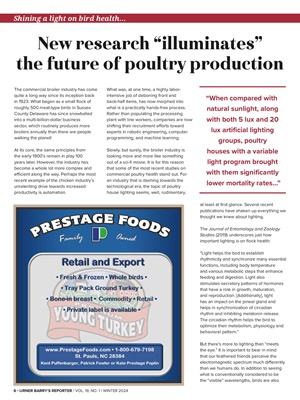
6 • URNER BARRY'S REPORTER / VOL. 19, NO. 1 / WINTER 2024
at least at first glance. Several recent
publications have shaken up everything we
thought we knew about lighting.
The Journal of Entomology and Zoology
Studies (2019) underscores just how
important lighting is on flock health:
"Light helps the bird to establish
rhythmicity and synchronize many essential
functions, including body temperature
and various metabolic steps that enhance
feeding and digestion. Light also
stimulates secretory patterns of hormones
that have a role in growth, maturation,
and reproduction. [Additionally], light
has an impact on the pineal gland and
helps in synchronization of circadian
rhythm and inhibiting melatonin release.
The circadian rhythm helps the bird to
optimize their metabolism, physiology and
behavioral pattern."
But there's more to lighting than "meets
the eye." It is important to bear in mind
that our feathered friends perceive the
electromagnetic spectrum much differently
than we humans do. In addition to seeing
what is conventionally considered to be
the "visible" wavelengths, birds are also
The commercial broiler industry has come
quite a long way since its inception back
in 1923. What began as a small flock of
roughly 500 meat-type birds in Sussex
County Delaware has since snowballed
into a multi-billion-dollar business
sector, which routinely produces more
broilers annually than there are people
walking the planet!
At its core, the same principles from
the early 1900's remain in play 100
years later. However, the industry has
become a whole lot more complex and
efficient along the way. Perhaps the most
recent example of the chicken industry's
unrelenting drive towards increased
productivity is automation.
What was, at one time, a highly laborintensive job of deboning front and
back-half items, has now morphed into
what is a practically hands-free process.
Rather than populating the processing
plant with line workers, companies are now
shifting their recruitment efforts toward
experts in robotic engineering, computer
programming, and machine learning.
Slowly, but surely, the broiler industry is
looking more and more like something
out of a sci-fi movie. It is for this reason
that some of the most recent studies on
commercial poultry health stand out. For
an industry that is dashing towards the
technological era, the topic of poultry
house lighting seems, well, rudimentary,
Shining a light on bird health…
New research "illuminates"
the future of poultry production
"When compared with
natural sunlight, along
with both 5 lux and 20
lux artificial lighting
groups, poultry
houses with a variable
light program brought
with them significantly
lower mortality rates..."